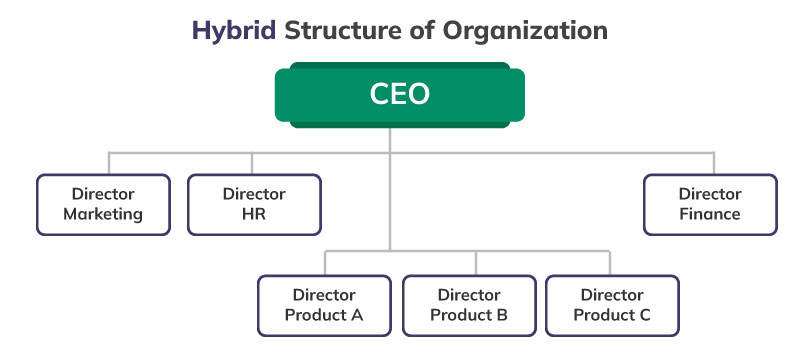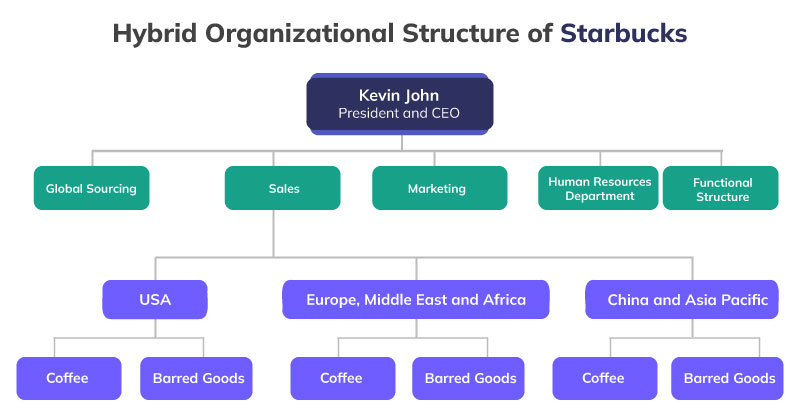Introduction to Hybrid Organizational Structure
As the term depicts, hybrid means a combination of two. A hybrid organizational structure is an organizational structure in which the organizational activities are divided into different departments which can be functional as well as divisional. Thus, the hybrid organizational structure includes a combination of the functional and the divisional organizational structure. The use of this organizational structure allows the organization to ensure collaborative sharing of data and resources.

Table of Contents
Functional as well as divisional organizational structure have their advantages and limitations. Hence, the organizations adopt the hybrid organizational structure to effectively manage the business processes. The main aim behind the hybrid organizational structure is to take advantage of functional as well as the divisional structure and minimize the limitations of both the organizational structure. Hence, the hybrid organizational structure features efficient use of resources and specialization in the functional structure and flexibility found in the divisional structure. The hybrid organizational structure is mainly used in the large organizations involved in manufacturing, non-profit sectors, service industries, or other multinational corporations. A hybrid organizational structure can help to streamline the business processes by interjecting a chain of command which can further help in improving the speed and efficiency of the organization.
The mixture of functional and product divisional organizational structure is the most common hybrid organizational structure. For instance, using this organizational structure, the organization can align the sales function with its product lines. A hybrid organizational structure can also help to engage employees in different work areas depending on the current assignment. For instance, the fast-food company while establishing the new product line can adopt the hybrid organizational structure and engage various experts from marketing, sales, research, and development departments to create new products. For instance, the fast-food company while establishing the new product line can adopt the hybrid organizational structure and engage various experts from marketing, sales, research, and development departments to create new products, supported with creative resources such as stock images for marketing campaigns.
Advantages of Hybrid Organizational Structure
Now, you must have got the idea that the hybrid organizational structure is more suitable for large organizations as it can help the organization to take advantage of functional as well as divisional structure. Some of the main advantages of the hybrid organizational structure are discussed as follows-
Efficiency- Hybrid organizational structure helps to enhance efficiency in the organization as the hybrid organizational structure is more flexible and helps to effectively manage various resources. Moreover, a hybrid organizational structure can also make sure that the right quantity of work is assigned to the right professionals at the right time which helps in ensuring optimum use of resources and increasing efficiency of the organization.
Company culture- The divisional organizational structure can also help to improve the organizational culture by facilitating clear roles and responsibilities for each employee.
Collaboration- The hybrid organizational structure helps in facilitating effective communication among the employees from different departments or the individuals with different skills and capabilities which helps in developing a collaborative work culture and preventing the risk of competitiveness among the different divisions of functions. The hybrid organizational structure can also help in developing the cross-functional skills among the employees as the employees with different skills and capabilities work together in the hybrid organizational structure which provides them the opportunity to learn a variety of skills from the other participants.
Flexibility- A hybrid organizational structure is more flexible as compared to the functional or divisional organizational structure as a healthy relationship is maintained between the senior managers and the junior employees which helps to address all the employee problems. Moreover, a hybrid organizational structure can also help to attune the business reporting according to the needs of the business. Greater flexibility in the organization structure can also help in ensuring higher customer satisfaction and higher organizational returns.
Disadvantages of Hybrid Organizational Structure
Despite various advantages of hybrid organizational structure, the hybrid organizational structure also suffers from various limitations regarding the risk of conflict and cost overrun. The disadvantages of hybrid organizational structure are discussed as follows-
Conflicts- Although a hybrid organizational structure can help in ensuring greater flexibility and efficiency in the operations, we need to consider that the hybrid organizational structure can also lead to conflict between the corporate departments and the divisions if the employee or some resource is needed for two projects simultaneously. This can lead to conflict between the vertical functions as well as the horizontal product lines and can result in a decline in the quality of operations.
Time and effort- Conflicting issues as a result of the hybrid organizational structure can lead to waste of time as well as effort and can also increase the cost of the operations of the organization. Moreover, the hybrid organizational structure also requires the organization to engage in regular meetings and discussions to plan the responsibilities of the employees and the managers which can also cause delays in the completion of various tasks.
Example of Hybrid Organizational Structure
You must be aware of the leading coffee company, Starbucks, and the core products of Starbucks. However, have you ever thought of the organizational structure being used by this coffee giant? It is a hybrid organizational structure that helps Starbucks to facilitate business development at the global level. The corporate structure of Starbucks helps to ensure that the organizational structure matches the needs of diverse customers.

The product divisions of Starbucks intersect with the functional groups and the geographical divisions. The functional groups of Starbucks include sales, marketing, human resource department, finance department, etc. The functional groups are at the top of the organizational hierarchy and thus, implement the strategies applicable at the global level. The geographical divisions of Starbucks include three regional divisions: USA, Europe, the Middle East, and Africa, and China and the Asia Pacific. Each geographical division of Starbucks has divisional heads including functional and geographic heads who implement the policies and strategies to ensure higher customer satisfaction. The product-based divisions of Starbucks address the product lines of the company which include coffee and baked goods.
FAQs
Can a Hybrid Organizational Structure adapt to changes or growth in an organization?
Yes, a hybrid structure is designed to be more adaptable to changes and growth. As the organization evolves or expands, it can adjust the balance between functional and divisional structures to accommodate new requirements.
Are there variations of the Hybrid Organizational Structure?
Yes, there can be various variations of the hybrid structure, depending on the organization's needs. Some organizations may have a stronger functional emphasis with project teams operating within the functions, while others may have a stronger divisional emphasis with functional support provided as needed.
Previous Structure
Divisional Organizational StructureNext Structure
Flat Organizational Structure
 Proof Reading
Proof Reading  Copy Writing
Copy Writing  Resume Writing
Resume Writing  Blogs
Blogs Guides
Guides SOP's
SOP's Student Resources
Student Resources Research Topics
Research Topics Login
Login Register
Register